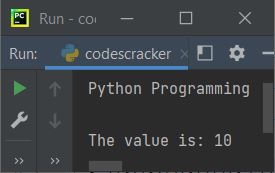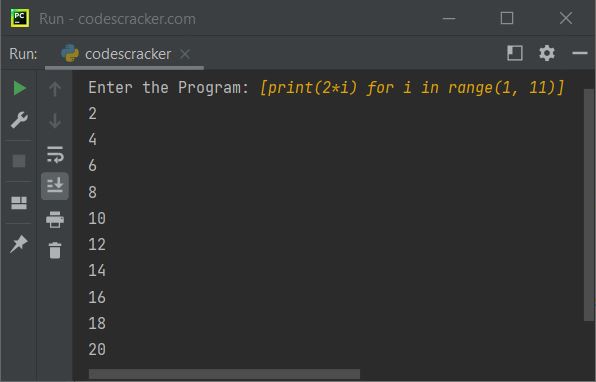- Python Built-in Functions
- Python All Built-in Functions
- Python print() Function
- Python input() Function
- Python int() Function
- Python float() Function
- Python len() Function
- Python range() Function
- Python str() Function
- Python ord() Function
- Python chr() Function
- Python ascii() Function
- Python pow() Function
- Python type() Function
- Python List Functions
- Python list() Function
- Python insert() Function
- Python append() Function
- Python extend() Function
- Python pop() Function
- Python remove() Function
- Python reverse() Function
- Python sort() Function
- Python sorted() Function
- Python Dictionary Functions
- Python dict() Function
- Python update() Function
- Python get() Function
- Python keys() Function
- Python setdefault() Function
- Python fromkeys() Function
- Python items() Function
- Python popitem() Function
- Python Tuple Function
- Python tuple() Function
- Python Set Functions
- Python set() Function
- Python frozenset() Function
- Python String Functions
- Python split() Function
- Python join() Function
- Python format() Function
- Python replace() Function
- Python Iterator Functions
- Python iter() Function
- Python min() Function
- Python max() Function
- Python sum() Function
- Python count() Function
- Python index() Function
- Python copy() Function
- Python clear() Function
- Python next() Function
- Python filter() Function
- Python enumerate() Function
- Python zip() Function
- Python reversed() Function
- Python Number Functions
- Python abs() Function
- Python bin() Function
- Python oct() Function
- Python hex() Function
- Python round() Function
- Python divmod() Function
- Python complex() Function
- Python File Handling Functions
- Python open() Function
- Python read() Function
- Python readable() Function
- Python readline() Function
- Python readlines() Function
- Python write() Function
- Python writable() Function
- Python writelines() Function
- Python close() Function
- Python seek() Function
- Python tell() Function
- Python flush() Function
- Python fileno() Function
- Python truncate() Function
- Python Class Functions
- Python object() Function
- Python property() Function
- Python getattr() Function
- Python setattr() Function
- Python hasattr() Function
- Python delattr() Function
- Python classmethod() Function
- Python staticmethod() Function
- Python issubclass() Function
- Python super() Function
- Python Misc Functions
- Python all() Function
- Python any() Function
- Python isatty() Function
- Python bool() Function
- Python callable() Function
- Python globals() Function
- Python locals() Function
- Python dir() Function
- Python id() Function
- Python isinstance() Function
- Python map() Function
- Python repr() Function
- Python slice() Function
- Python vars() Function
- Python Advance Functions
- Python help() Function
- Python hash() Function
- Python breakpoint() Function
- Python bytes() Function
- Python bytearray() Function
- Python memoryview() Function
- Python compile() Function
- Python eval() Function
- Python exec() Function
- Python Tutorial
- Python Tutorial
- Python Examples
- Python Examples
Python exec() Function
The exec() function in Python is used to execute a block of code. Basically this function is used when we need to execute dynamically created codes. For example:
x = 'print("Python Programming")' exec(x) x = "val = 10\nprint(\"\\nThe value is:\", val)" exec(x)
The snapshot given below shows its sample output:

Note: Unlike eval(), that evaluates single dynamically generated expression. The exec() function executes dynamically generated code.
Note: Unlike eval(), exec() takes single expression as well as a block of code to execute.
Python exec() Function Syntax
The syntax of exec() function in Python is:
exec(object, globals, locals)
where:
- object - may be a string containing the expression or code, or it may be a code object
- globals - refers to a dictionary
- locals - refers to a mapping object. Dictionary is a standard mapping type
Note: The first parameter, object is required. And the other two parameters are optional.
Python exec() Function Example
Here is a simple example demonstrating the exec() function in Python. This program actually shows how the exec() function can be used to execute the dynamic code. In this program, user is allowed to create the code at run-time. The created code by user, will get executed dynamically:
print("Enter the Program: ", end="") p = input() exec(p)
The sample run with user input [print(2*i) for i in range(1, 11)] is shown in the snapshot given below:

After the user input, the following statement:
exec(p)
gets converted into the statement given below:
exec("[print(2*i) for i in range(1, 11)]")
Note: The input() function treats anything entered by user at run-time as a String type.
Important - To execute dynamically generated codes that are expanded in multiple lines, then use compile() method before exec() to compile the code first, then execute using of course, the exec() method. The detailed description with example about compile() function is provided in its separate tutorial.
Important - Be sure to validate the input before putting into exec() to execute. Because attacker may try to execute some harmful codes like deleting some useful files or information.
« Previous Function Python Tutorial »